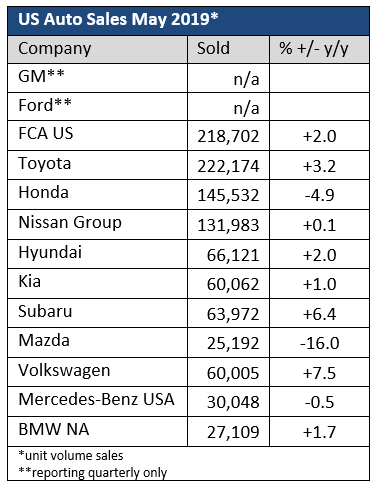Steel Markets

May Auto Sales Better Than Expected
Written by Sandy Williams
June 3, 2019
May turned out to be a good month for several automakers. Fiat Chrysler, Toyota and Nissan all reported year-over-year gains. Fiat Chrysler posted a 2 percent gain in May, its first monthly increase since January, while Toyota jumped 3.2 percent and Nissan 0.1 percent.

Overall sales totaled 1.587 million, a year-over-year decline of 0.3 percent, according to Automotive News. The seasonally adjusted annual rate of sales for May was 17.4 million, beating forecasts of 16.9 million.
“Volatility is a new ingredient in the market and it’s likely to be like this for the rest of the year,” said Charlie Chesbrough, an economist for Cox Automotive. “It’s hard to know if May’s results are an indicator of a robust summer ahead or more volatility ultimately leading into a downward trend for the year.”
New Headache for the Industry
The auto industry thought potential Section 232 tariffs on autos was their immediate concern, but now proposed tariffs on Mexico bring new worries. The tariffs would affect billions of dollars of auto and auto parts imports. Nearly $60 billion in auto parts were imported from Mexico in 2018 and about 2.5 million Mexican-made vehicles.
A short-term tariff of 5 percent can be weathered by the industry, says Jeff Schuster, LMC Automotive’s president for global forecasting, but an increase to 25 percent would be substantial.
In an analysis by Deutche Bank, a 25 percent tariff would cost General Motors $6.3 billion, FCA $4.8 billion and Ford $3.3 billion.
“That means lower margins and less investment and R&D spending,” said Kristin Dziczek, vice president of industry, labor and economics at the Center for Automotive Research. Dziczek said if the USMCA fails to pass and the president withdraws from NAFTA, there will be no incentive for businesses to move back to the U.S. when they can move to other low-cost countries.

Sandy Williams
Read more from Sandy WilliamsLatest in Steel Markets

CMC looks beyond Arizona micro-mill woes to long-term viability of construction mart
Despite the economic and geopolitical upheaval of the last five years, CMC President and CEO Peter Matt points out that the construction market has been an essential element of the way forward.

US importers face stricter rules under revamped S232 tariffs
“CBP expects full compliance from the trade community for accurate reporting and payment of the additional duties. CBP will take enforcement action on non-compliance," the agency said in a March 7 bulletin.

Steel exports rebound in January
US steel exports recovered to a five-month high in January after having fallen to a two-year low in December. This growth follows four consecutive months of declining exports.

Construction spending drops marginally in January
Construction spending edged down slightly in January, slipping for the first time in four months. The US Census Bureau estimated spending at a seasonally adjusted annual rate of $2,196 billion in January, down 0.2% from December’s downward revised rate. The January figure is 3.3% higher than a year ago. January’s result, despite the slight erosion, […]

HVAC equipment shipments slow in December but strong annually
Shipments of heating and cooling equipment in the US fell to an 11-month low in December, according to the latest data released by the Air-Conditioning, Heating, and Refrigeration Institute (AHRI).
